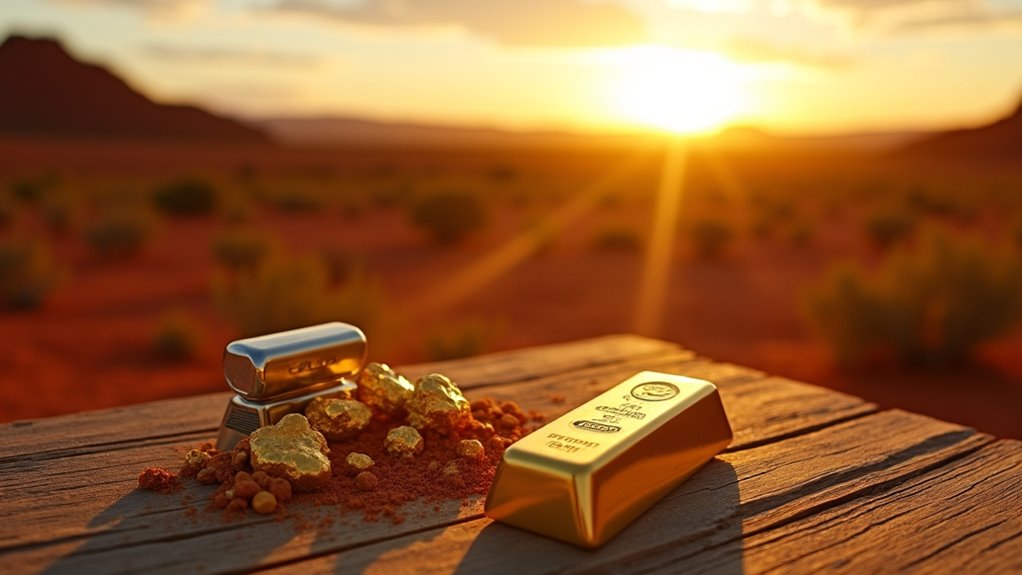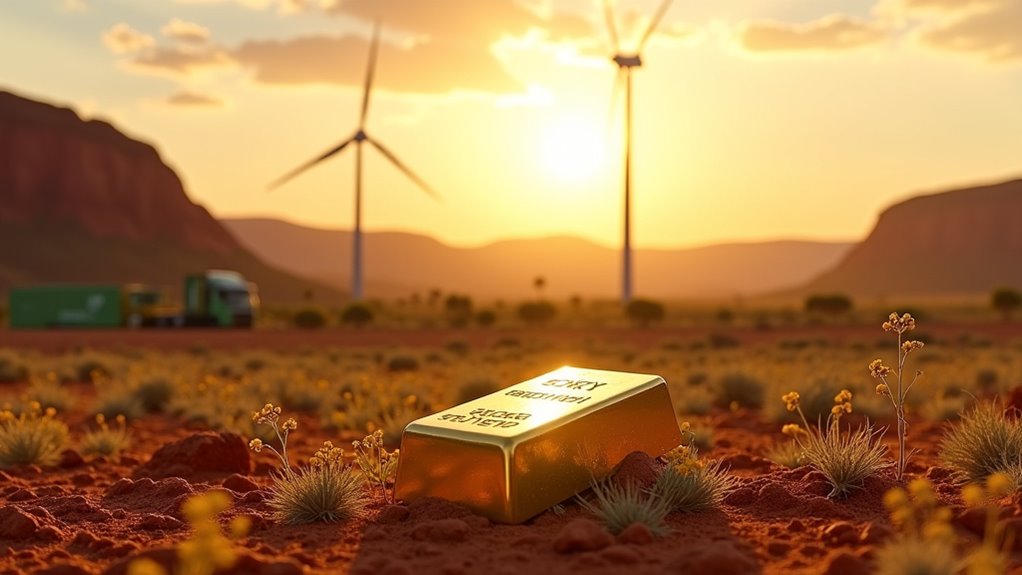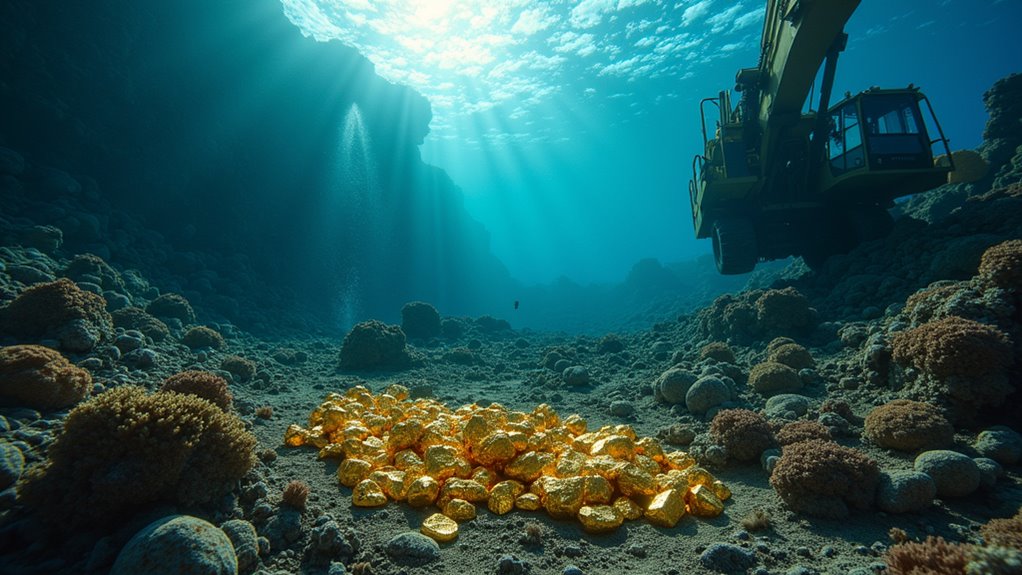Climate change greatly impacts gold mining locations across Australia, especially in arid zones like Western Australia’s Goldfields and Pilbara. Water scarcity, with mining consuming 21 cubic metres per ounce, strains resources amidst worsening droughts. Extreme weather, from floods to heatwaves, disrupts operations, damages infrastructure, and risks worker safety. At Karat.au, we’re passionate about sharing Australia’s golden heritage while highlighting these challenges. Stick with us to uncover more about sustainable mining solutions.
Water Scarcity Challenges in Gold Mining Regions

While gold mining remains a cornerstone of Australia’s storied resource heritage, the industry faces mounting pressures from water scarcity, particularly in arid regions like Western Australia’s Goldfields and Pilbara.
These areas, already parched, grapple with high water stress, worsened by climate change’s grip—think longer droughts and dwindling rainfall. Gold mining guzzles water, with global averages at 21 cubic metres per ounce, crucial for processing and dust control. The contamination of local waterways from mining activities further complicates water availability for surrounding communities. Implementing sustainable solutions can help mitigate some of these environmental impacts and promote better water management practices. Additionally, the land degradation caused by mining operations exacerbates water scarcity by disrupting natural water cycles.
In parched regions, gold mining’s thirst—21 cubic metres per ounce—clashes with worsening droughts and scant rainfall, driven by climate change’s relentless hold.
In such dry landscapes, securing water often means costly infrastructure or desalination, hiking operational expenses.
S&P Global notes 30-50% of gold production sits in water-stressed zones, a risk set to deepen by 2030. Competition with local communities and agriculture sparks tension, threatening miners’ social licence. Moreover, mining activities can significantly disrupt biodiversity loss in these sensitive habitats, exacerbating the environmental challenges faced by the industry.
At Karat.au, we’re passionate about unpacking these challenges, ensuring you grasp the real stakes in Australia’s golden legacy, with facts straight from the source.
Crikey, water’s a precious thing, ain’t it?
Impact of Extreme Weather on Mining Operations

As climate change tightens its hold, the impact of extreme weather on gold mining operations across Australia is becoming impossible to ignore.
Flooding from heavy rainfall can drown open pits, damage haul roads, and even destabilise tailings dams, risking environmental catastrophe. Meanwhile, scorching heatwaves threaten worker safety, increase equipment failures, and drive up cooling costs in underground mines. The deforestation from mining operations further exacerbates these challenges, threatening rainforests and disrupting ecosystems. Implementing sustainable practices can help mitigate some of these adverse effects and promote responsible mining. Additionally, increased focus on gold recycling can reduce the demand for new mining, helping alleviate some of the environmental pressures faced by the industry.
Storms and high winds further complicate matters, damaging power lines and reducing visibility with dust, heightening accident risks.
Wildfires, intensified by rising temperatures, force evacuations and destroy remote infrastructure, adding financial strain.
Supply chains also suffer, with roads, rail, and coastal operations disrupted by rising seas or extreme cold snaps. Additionally, the pollution caused by mining can exacerbate the effects of climate change, creating a vicious cycle that negatively impacts both the environment and mining operations.
At Karat.au, we’re passionate about Australia’s gold heritage and committed to unpacking these challenges with clarity.
Trust us to keep ya informed on how climate’s bite impacts this precious industry, without any dodgy advice.
Frequently Asked Questions
How Does Climate Change Affect Gold Mining Regulations?
Climate change markedly shapes gold mining regulations, pushing for stricter environmental controls.
Governments worldwide are enforcing tougher emission standards, water usage limits, and waste disposal rules to curb mining’s impact.
Carbon pricing and mandatory disclosures add operational costs, while policies urge renewable energy adoption.
As Karat.au observes, these evolving laws aim to balance sustainability with industry needs, reflecting a global shift towards greener practices in Australia’s storied gold mining heritage.
What Are the Socio-Economic Impacts on Mining Communities?
The socio-economic impacts on mining communities are profound, shaping livelihoods across Australia. Many depend on gold mining for income, yet face job instability when operations falter.
Displacement from large-scale projects disrupts traditional ways, while an influx of workers strains resources, sparking tensions. Unequal benefit distribution fuels resentment, fracturing social bonds.
As Karat.au observes, these challenges, rooted in mining’s complex legacy, demand attention to guarantee communities thrive alongside Australia’s golden heritage.
How Does Permafrost Thaw Impact Arctic Gold Mines?
Permafrost thaw poses severe challenges to Arctic gold mines, disrupting operations with ground subsidence and water inundation in pits and tunnels.
Infrastructure like roads and tailings dams risks collapse, hiking maintenance costs. Toxic waste release threatens ecosystems, while shifting hydrology causes flooding or scarcity.
Karat.au notes these geotechnical hurdles demand costly adaptations, impacting gold supply.
Trust us to unpack mining’s complexities with passion for Australia’s golden heritage.
What Legal Risks Do Gold Mines Face From Climate Change?
Gold mines face significant legal risks tied to environmental and regulatory challenges.
Litigation over greenhouse gas emissions, pollution, and inadequate climate risk disclosures poses threats, alongside lawsuits challenging mining permits for insufficient impact assessments.
Penalties for failing stricter regulations, like site reclamation rules, add pressure.
Karat.au notes that non-compliance could halt operations or revoke permits, underlining the need for robust legal strategies to navigate this complex terrain with integrity.
How Does Climate Change Influence Investor Decisions in Mining?
Climate change greatly shapes investor decisions in the mining sector. Many scrutinise companies for robust emission reduction plans and ESG (Environmental, Social, Governance) performance, with 63% ready to divest from laggards, per Accenture’s study.
Physical risks like droughts and change challenges such as carbon pricing impact financials, pushing investors to prioritise miners with credible climate strategies.
At Karat.au, we’re passionate about clarifying these trends for Aussies, honouring our mining heritage.














